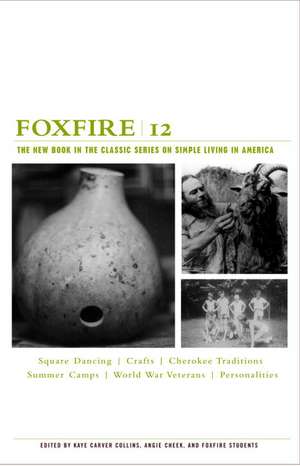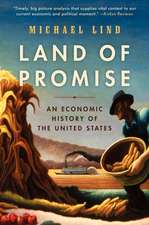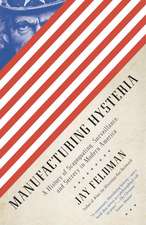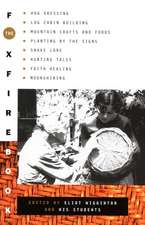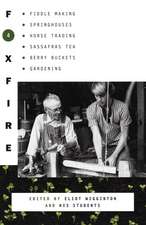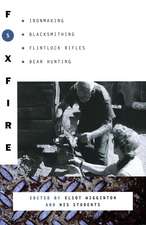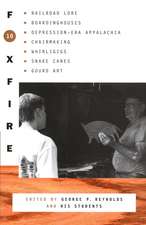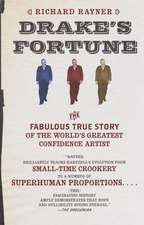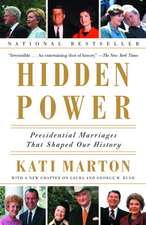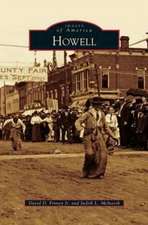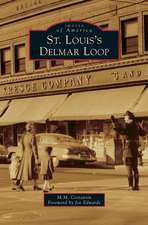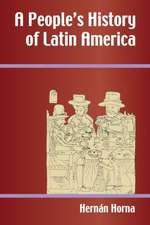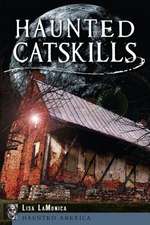Foxfire 12: Foxfire Series
Autor Foxfire Fund Incen Limba Engleză Paperback – 31 aug 2004
Foxfire 12 is the latest volume, the first in more than five years. Here are reminiscences about learning to square dance and tales about traditional craftsmen who created useful items in the old-time ways that have since disappeared in most of the country. Here are lessons on how to make rose beads and wooden coffins, and on how to find turtles in your local pond. We hear the voices of descendants of the Cherokees who lived in the region, and we learn about what summer camp was like for generations of youngsters. We meet a rich assortment of Appalachian characters and listen to veterans recount their war experiences. Illustrated with photographs and drawings, Foxfire 12 is a rich trove of information and stories from a fascinating American culture.
Preț: 140.65 lei
Nou
Puncte Express: 211
Preț estimativ în valută:
26.92€ • 27.100$ • 22.22£
26.92€ • 27.100$ • 22.22£
Carte disponibilă
Livrare economică 24 martie-07 aprilie
Preluare comenzi: 021 569.72.76
Specificații
ISBN-13: 9781400032617
ISBN-10: 140003261X
Pagini: 576
Ilustrații: 200 ILLUSTRATIONS
Dimensiuni: 147 x 241 x 29 mm
Greutate: 0.69 kg
Editura: Anchor Books
Seria Foxfire Series
ISBN-10: 140003261X
Pagini: 576
Ilustrații: 200 ILLUSTRATIONS
Dimensiuni: 147 x 241 x 29 mm
Greutate: 0.69 kg
Editura: Anchor Books
Seria Foxfire Series
Extras
Chapter 1
CHES McCARTNEY:
THE LEGEND OF THE GOAT MAN
"The goats have taught me a lot in the past thirty years. They don't, for example, care how I smell or how I look. They trust me and have faith in me, and this is more than I can say for a lot of people." -Qtd. in Patton 7
I am not originally from Rabun County. Because I am from the Lone Star State-Texas-I had never heard of the Goat Man. Although I now know that he has been in forty-nine of the fifty states of America (all except Hawaii), he is not as well known in Texas as he is in Georgia. I've lived here in Northeast Georgia for three years, and his name has been mentioned off and on in conversations with home folks. As everybody does, when, as an outsider, you're unfamiliar with a subject, you often tend to pay it no attention because the name means nothing to you. My lack of knowledge on the subject of America's Goat Man was about to change.
After I was chosen to work at Foxfire during the summer program and had completed some unfinished articles, someone mentioned the Goat Man. I was intrigued. This man, for many decades, up to 1987, with and without goats (mostly with), traveled all over the continental United States. At the time, most did not know his real name or where he was from.
I learned that the Goat Man always appeared, along with about twelve to thirty goats-which "he proudly called his maternity ward" (Patton 3) or his babies (Patton 19)-and wagons full of junk, around the time of Clayton, Georgia's Mountaineer Festival, a celebration that used to be an annual event. There are various accounts of Charlie, Chester, better known as Chess or Ches McCartney, aka the Goat Man, that tell of sightings of his strange caravan over the span of thirty-eight to fifty-five years. (For the record, I have found various names and many different spellings of Mr. McCartney's name, but in an effort to remain as historically accurate as possible, the spelling of Ches McCartney's name is the same as his signature.) The sightings became rarer until finally there were none at all. Georgia newspapers began reporting that the Goat Man had retired from the road, and folks began telling tales of his demise. I wanted to meet this national legend, so in trying to find out anything I could, I called local libraries and newspapers. My search ended successfully: Mr. McCartney was in a nursing home in Macon, Georgia. Having fractured his hip, he, at a self-professed one hundred and five years of age (he was probably several years younger), was in a wheelchair. His white hair peeked out from underneath his blue cap, and his blue eyes, set in his weathered face, sparkled and danced as he recounted the tales of the roads he has traveled.
This article represents research from various sources: personal interviews with some eyewitnesses from Rabun County, Georgia, and others who have vivid memories of the Goat Man, and my own interview with Mr. McCartney, as well as quotes from the pamphlets he sold during his traveling years. Darryl Patton's book America's Goat Man (Mr. Ches McCartney), used with permission, was an invaluable resource.
Some who met Ches McCartney thought he was a friendly genius; others thought him filthy and crazed. All, however, remember the Goat Man as a mysterious, eccentric, legendary character, a gypsy mountain man, a folk hero who followed his own way, herding goats from Florida to Maine, from Washington, D.C., to California. "Like a Knight of the Round Table," Mr. McCartney once averred, "I am in search of the Holy Grail" (qtd. in Patton 55). -Stephanie Dollar and Angie Cheek
Ches McCartney was born in the early 1900s, on the farm of his parents near Van Buren Township, Keokuk County, Iowa, the son of Albert McCartney and Louise E. Russell McCartney. He lived there until he was fourteen years old. He ran off to New York City and, at the age of fourteen, married a twenty-four-year-old Spanish knife thrower who threw knives at him in local bars to make tips. Charlie (Ches) recounted that his wife "threw the knives in his general direction: she would throw a couple to attract attention; then as the coins hit the floor, she would throw all twenty-five. The closer the knives came to Charlie, the bigger the tips. Charlie was unable to grow a long, flowing beard during this time" (qtd. in Patton 73).
The pair discovered they were going to have a child, so Ches invested in a sturdy team of horses, some goats, and a twenty-acre farm near his childhood home in the What Cheer community of Iowa. Albert Gene (Bert/Gene) was born here. McCartney averred that his son thrived "on pure country air, vegetables, spring water, and plenty of goat's milk" (qtd. in Patton 74). Life was good for a time. Ches even became "a devoted reader of the Bible and started expounding the Gospel to his fellow man" (qtd. in Patton 74).
Then came the Depression. No market existed for their abundant crops, and during an extremely hard winter, they lost both their horses. McCartney related the misfortunes that befell him when the Depression of 1929 hit hard: "I lost my life savings in the bank failure and had to take a job on the Works Project [Progress] Administration-the well-known WPA" (qtd. in Patton 6). Most people farmed in that area. You were either a farmer or a log cutter, or you worked for the government in the WPA, CCA, or CCC. "While he was working for the WPA, a tree fell on him and left him with a crushed lung, a crushed left shoulder, a deformed left elbow, and a smashed right hip" (Patton 25). According to Darryl Patton, "He was left for dead for a while before they found him." McCartney said he lay there for hours before anyone came to help: "They thought I was dead and took me to the undertaker. He was sticking the embalming needle in me when I woke up" (qtd. in Patton 14). "Luckily," as McCartney so succinctly put it, "the undertaker was slow" (qtd. in Patton 6). The Goat Man ended up with a permanently mangled arm and shoulder. In fact, his arm was so crushed that he couldn't do heavy work.
After the physical limitations caused by his injuries in the WPA accident and the Depression exacerbated his problems, he came to a realization: He had a family and needed money. He needed a gimmick: He liked Robinson Crusoe and liked preaching. McCartney decided that there "were places to be seen, and a challenge to be met" (qtd. in Patton 74). He had his wife make them goatskin clothes. He hitched a number of billy goats to the front of a ramshackle handcrafted wagon, loaded his wife and son onto it, traveled around locally, and finally decided to hit the roads of America for good. McCartney related that the challenge "proved too harrowing for Mrs. McCartney (a 1984 article in The Atlanta Journal-Constitution reported Albert Gene's mother's name as Saddie Smythheart), and [Ches] awakened one morning to find that their party of three was now a party of two" (qtd. in Patton 74-75): himself and Gene. Ches said, "She went away and left me and the boy . . . took up with another man" (qtd. in Patton 33). Some purport that Ches soon returned to Iowa, left his son with grandparents who enrolled him in school, and, thereafter, returned to his travels. Many witnesses, however, testify to having seen his son with him, even as a teenager. In fact, most agree that Gene traveled, off and on, with his father until the age of fifteen. A Fayetteville, North Carolina news reporter commented about one encounter with father and son: "Gene's face clouded with petulance . . . The old man grinned at him. 'He thinks he knows as much as the Lord . . . but he's stupid' . . . Gene crawled out of the wagon. His teeth were rotten. He hummed vacuously to himself . . . crawled out of the top of the wagon and began loosening tubs . . . let them crash to the ground" (qtd. in Patton 33). Ches McCartney, with or without his son, set out across the country to fulfill his wanderlust, and the rest, as they say, is history.
"His hair and beard were long and shabby and would remind you of a stump full of 'Granddaddy long legs.' -Qtd. in Patton 21
A writer for The Atlanta Journal-Constitution reported that the Goat Man was five feet eleven in height, weighed 190 pounds, and had a beard that reached almost to the hipline (Patton 25). One witness claimed to have a vivid recollection of the Goat Man in the summer or fall of 1948, '49, or '50: "The Goat Man's appearance was pitiful to say the least. His clothes were old, tattered, and soiled beyond belief. His hair and beard were long and shabby and would remind you of a stump full of 'Granddaddy long legs' " (qtd. in Patton 21).
"A lady asked me when I last had a bath, and I told her probably when my parents bathed me sixty-five years ago. -Qtd. in Patton 69
An article that appeared in The Rome [Georgia] News Tribune described his appearance in 1969: "His skin, stained molasses brown from years of sleeping in fields and forests, and his shaggy, grisly beard give him the appearance of an elderly hippie who forgot to file for Medicare" (qtd. in Patton 83). "His attire consist[ed] of blackened overalls, a dirty, shredded jacket, brogans, and a ball cap that was once some other color" (qtd. in Patton 57). "The smell was so bad that it was hard to get close to him or the wagon" (qtd. in Patton 21). In fact, McCartney himself vowed he hadn't had a bath in "God knows when" (qtd. in Patton 55). "A lady asked me when I last had a bath, and I told her probably when my parents bathed me sixty-five years ago" (qtd. in Patton 69).
"The junk inside the wagon bed was so arranged it looked like a billy goat's stomach all screwed up" (qtd. in Patton 21). The Anniston, Alabama newspaper, The Anniston Star, reported that the wagon was "decorated with everything from George Wallace stickers to signs warning 'Prepare to meet thy God' " (qtd. in Patton 104). A Savannah Morning News reporter wrote, "It was really a dual wagon-a main vehicle and trailer, six goats pulling, seven hitched to the trailer, and about a dozen spares hitched alongside. The main wagon had four wheels, the trailer two. Both were piled high with pots, pans, lanterns, sleeping gear, and Lord knows what else" (qtd. in Patton 113). Arleen Snow says, "I remember in our crowd we all stood quietly in awe just to survey the whole scene. It was so unusual because here was this man with a long beard and long hair back in the early sixties, and the wagon would literally be covered in pots and pans and trinkets and junk. Barely could you see the wagon itself for all the junk. He would sell his junk." A reporter for The Charleston Post Courier described the strange sight: "The wagons rest on makeshift wheels and chassis, and the front wagon is a crude affair, fashioned from pieces of metal. The singletrees were whittled out by a pocketknife. The harness is handsewn leather, stitched to fit the various-sized goats. The driver sits in the first wagon and is aided by rearview mirrors on each side. The sides are built up out of boards, tin cans, license plates, glass, wire, bottles, tree branches, straw, pots and pans, rope, tinfoil, canvas, cloth, etc. Kerosene lanterns, used for parking at night and camp illumination, hang from the four corners. The crippled goats ride on a ledge in the first unit. Small windmill ornaments turn merrily in the breeze. Bins of hay and oats for the animals are stored in the wagon. Tubs for watering are also among the equipment" (qtd. in Patton 29).
"He would sell his postcards: one for twenty-five cents, two for fifty cents, and three for a dollar; and the people that would buy three for a dollar would think they had gotten a great deal and would go home and just hit themselves when they realized what they had done. My uncle was one of those." -Arleen Snow
Apparently the Goat Man and his entourage traveled "about 2.5 miles per hour and with time out for camping, milking, and feeding, a total of 12 miles a day would be about a top day's journey" (qtd. in Patton 22). In his travels, Ches McCartney, who now was becoming infamous as the Goat Man, always had a scheme to make money. The curious wanted him to pose for photographs; he heard others express regret at not having brought a camera. In pamphlets, McCartney then compiled answers to the questions he was asked most frequently; he had photographs taken of him and his goats; he made copies in the form of postcards and made them available to anyone interested. He sold these postcards from a large garbage can. Arleen Snow can remember a gimmick: "He never did sell any of his junk expensive. He was a crafty fella; he was a businessman. I consider him an entrepreneur in his own way. For instance, he would sell his postcards: one for twenty-five cents, two for fifty cents, and three for a dollar; and the people that would buy three for a dollar would think they had gotten a great deal and would go home and just hit themselves when they realized what they had done. My uncle was one of those." "The Goat Man would," Darryl Patton recalls, "start a fire out of whatever sticks, pieces of paper, and other trash he could find. The final touch was always an old tire scrounged from the side of the road during his travels . . . Standing in a cloud of thick, acrid black smoke, he would wait for the crowds he knew would come just as surely as moths attracted to a flame . . . The oily black smoke billowing up from his campfire was just one of many ploys he used. This not only worked, but worked well, as people for miles around would see the smoke, and wondering if there had been an automobile accident, would immediately go to investigate. Once they made it to his campsite, they would rarely leave without having parted with a dollar or two for his wares" (Patton 2). Besides selling postcards and booklets, he sold anything he could pick up, anything he could fit on his wagon. "Through the sale of these photographs and this literature, Ches was able to put his son through college, build several churches, and acquire some real estate." He "paid the government in cash" (Patton 75).
CHES McCARTNEY:
THE LEGEND OF THE GOAT MAN
"The goats have taught me a lot in the past thirty years. They don't, for example, care how I smell or how I look. They trust me and have faith in me, and this is more than I can say for a lot of people." -Qtd. in Patton 7
I am not originally from Rabun County. Because I am from the Lone Star State-Texas-I had never heard of the Goat Man. Although I now know that he has been in forty-nine of the fifty states of America (all except Hawaii), he is not as well known in Texas as he is in Georgia. I've lived here in Northeast Georgia for three years, and his name has been mentioned off and on in conversations with home folks. As everybody does, when, as an outsider, you're unfamiliar with a subject, you often tend to pay it no attention because the name means nothing to you. My lack of knowledge on the subject of America's Goat Man was about to change.
After I was chosen to work at Foxfire during the summer program and had completed some unfinished articles, someone mentioned the Goat Man. I was intrigued. This man, for many decades, up to 1987, with and without goats (mostly with), traveled all over the continental United States. At the time, most did not know his real name or where he was from.
I learned that the Goat Man always appeared, along with about twelve to thirty goats-which "he proudly called his maternity ward" (Patton 3) or his babies (Patton 19)-and wagons full of junk, around the time of Clayton, Georgia's Mountaineer Festival, a celebration that used to be an annual event. There are various accounts of Charlie, Chester, better known as Chess or Ches McCartney, aka the Goat Man, that tell of sightings of his strange caravan over the span of thirty-eight to fifty-five years. (For the record, I have found various names and many different spellings of Mr. McCartney's name, but in an effort to remain as historically accurate as possible, the spelling of Ches McCartney's name is the same as his signature.) The sightings became rarer until finally there were none at all. Georgia newspapers began reporting that the Goat Man had retired from the road, and folks began telling tales of his demise. I wanted to meet this national legend, so in trying to find out anything I could, I called local libraries and newspapers. My search ended successfully: Mr. McCartney was in a nursing home in Macon, Georgia. Having fractured his hip, he, at a self-professed one hundred and five years of age (he was probably several years younger), was in a wheelchair. His white hair peeked out from underneath his blue cap, and his blue eyes, set in his weathered face, sparkled and danced as he recounted the tales of the roads he has traveled.
This article represents research from various sources: personal interviews with some eyewitnesses from Rabun County, Georgia, and others who have vivid memories of the Goat Man, and my own interview with Mr. McCartney, as well as quotes from the pamphlets he sold during his traveling years. Darryl Patton's book America's Goat Man (Mr. Ches McCartney), used with permission, was an invaluable resource.
Some who met Ches McCartney thought he was a friendly genius; others thought him filthy and crazed. All, however, remember the Goat Man as a mysterious, eccentric, legendary character, a gypsy mountain man, a folk hero who followed his own way, herding goats from Florida to Maine, from Washington, D.C., to California. "Like a Knight of the Round Table," Mr. McCartney once averred, "I am in search of the Holy Grail" (qtd. in Patton 55). -Stephanie Dollar and Angie Cheek
Ches McCartney was born in the early 1900s, on the farm of his parents near Van Buren Township, Keokuk County, Iowa, the son of Albert McCartney and Louise E. Russell McCartney. He lived there until he was fourteen years old. He ran off to New York City and, at the age of fourteen, married a twenty-four-year-old Spanish knife thrower who threw knives at him in local bars to make tips. Charlie (Ches) recounted that his wife "threw the knives in his general direction: she would throw a couple to attract attention; then as the coins hit the floor, she would throw all twenty-five. The closer the knives came to Charlie, the bigger the tips. Charlie was unable to grow a long, flowing beard during this time" (qtd. in Patton 73).
The pair discovered they were going to have a child, so Ches invested in a sturdy team of horses, some goats, and a twenty-acre farm near his childhood home in the What Cheer community of Iowa. Albert Gene (Bert/Gene) was born here. McCartney averred that his son thrived "on pure country air, vegetables, spring water, and plenty of goat's milk" (qtd. in Patton 74). Life was good for a time. Ches even became "a devoted reader of the Bible and started expounding the Gospel to his fellow man" (qtd. in Patton 74).
Then came the Depression. No market existed for their abundant crops, and during an extremely hard winter, they lost both their horses. McCartney related the misfortunes that befell him when the Depression of 1929 hit hard: "I lost my life savings in the bank failure and had to take a job on the Works Project [Progress] Administration-the well-known WPA" (qtd. in Patton 6). Most people farmed in that area. You were either a farmer or a log cutter, or you worked for the government in the WPA, CCA, or CCC. "While he was working for the WPA, a tree fell on him and left him with a crushed lung, a crushed left shoulder, a deformed left elbow, and a smashed right hip" (Patton 25). According to Darryl Patton, "He was left for dead for a while before they found him." McCartney said he lay there for hours before anyone came to help: "They thought I was dead and took me to the undertaker. He was sticking the embalming needle in me when I woke up" (qtd. in Patton 14). "Luckily," as McCartney so succinctly put it, "the undertaker was slow" (qtd. in Patton 6). The Goat Man ended up with a permanently mangled arm and shoulder. In fact, his arm was so crushed that he couldn't do heavy work.
After the physical limitations caused by his injuries in the WPA accident and the Depression exacerbated his problems, he came to a realization: He had a family and needed money. He needed a gimmick: He liked Robinson Crusoe and liked preaching. McCartney decided that there "were places to be seen, and a challenge to be met" (qtd. in Patton 74). He had his wife make them goatskin clothes. He hitched a number of billy goats to the front of a ramshackle handcrafted wagon, loaded his wife and son onto it, traveled around locally, and finally decided to hit the roads of America for good. McCartney related that the challenge "proved too harrowing for Mrs. McCartney (a 1984 article in The Atlanta Journal-Constitution reported Albert Gene's mother's name as Saddie Smythheart), and [Ches] awakened one morning to find that their party of three was now a party of two" (qtd. in Patton 74-75): himself and Gene. Ches said, "She went away and left me and the boy . . . took up with another man" (qtd. in Patton 33). Some purport that Ches soon returned to Iowa, left his son with grandparents who enrolled him in school, and, thereafter, returned to his travels. Many witnesses, however, testify to having seen his son with him, even as a teenager. In fact, most agree that Gene traveled, off and on, with his father until the age of fifteen. A Fayetteville, North Carolina news reporter commented about one encounter with father and son: "Gene's face clouded with petulance . . . The old man grinned at him. 'He thinks he knows as much as the Lord . . . but he's stupid' . . . Gene crawled out of the wagon. His teeth were rotten. He hummed vacuously to himself . . . crawled out of the top of the wagon and began loosening tubs . . . let them crash to the ground" (qtd. in Patton 33). Ches McCartney, with or without his son, set out across the country to fulfill his wanderlust, and the rest, as they say, is history.
"His hair and beard were long and shabby and would remind you of a stump full of 'Granddaddy long legs.' -Qtd. in Patton 21
A writer for The Atlanta Journal-Constitution reported that the Goat Man was five feet eleven in height, weighed 190 pounds, and had a beard that reached almost to the hipline (Patton 25). One witness claimed to have a vivid recollection of the Goat Man in the summer or fall of 1948, '49, or '50: "The Goat Man's appearance was pitiful to say the least. His clothes were old, tattered, and soiled beyond belief. His hair and beard were long and shabby and would remind you of a stump full of 'Granddaddy long legs' " (qtd. in Patton 21).
"A lady asked me when I last had a bath, and I told her probably when my parents bathed me sixty-five years ago. -Qtd. in Patton 69
An article that appeared in The Rome [Georgia] News Tribune described his appearance in 1969: "His skin, stained molasses brown from years of sleeping in fields and forests, and his shaggy, grisly beard give him the appearance of an elderly hippie who forgot to file for Medicare" (qtd. in Patton 83). "His attire consist[ed] of blackened overalls, a dirty, shredded jacket, brogans, and a ball cap that was once some other color" (qtd. in Patton 57). "The smell was so bad that it was hard to get close to him or the wagon" (qtd. in Patton 21). In fact, McCartney himself vowed he hadn't had a bath in "God knows when" (qtd. in Patton 55). "A lady asked me when I last had a bath, and I told her probably when my parents bathed me sixty-five years ago" (qtd. in Patton 69).
"The junk inside the wagon bed was so arranged it looked like a billy goat's stomach all screwed up" (qtd. in Patton 21). The Anniston, Alabama newspaper, The Anniston Star, reported that the wagon was "decorated with everything from George Wallace stickers to signs warning 'Prepare to meet thy God' " (qtd. in Patton 104). A Savannah Morning News reporter wrote, "It was really a dual wagon-a main vehicle and trailer, six goats pulling, seven hitched to the trailer, and about a dozen spares hitched alongside. The main wagon had four wheels, the trailer two. Both were piled high with pots, pans, lanterns, sleeping gear, and Lord knows what else" (qtd. in Patton 113). Arleen Snow says, "I remember in our crowd we all stood quietly in awe just to survey the whole scene. It was so unusual because here was this man with a long beard and long hair back in the early sixties, and the wagon would literally be covered in pots and pans and trinkets and junk. Barely could you see the wagon itself for all the junk. He would sell his junk." A reporter for The Charleston Post Courier described the strange sight: "The wagons rest on makeshift wheels and chassis, and the front wagon is a crude affair, fashioned from pieces of metal. The singletrees were whittled out by a pocketknife. The harness is handsewn leather, stitched to fit the various-sized goats. The driver sits in the first wagon and is aided by rearview mirrors on each side. The sides are built up out of boards, tin cans, license plates, glass, wire, bottles, tree branches, straw, pots and pans, rope, tinfoil, canvas, cloth, etc. Kerosene lanterns, used for parking at night and camp illumination, hang from the four corners. The crippled goats ride on a ledge in the first unit. Small windmill ornaments turn merrily in the breeze. Bins of hay and oats for the animals are stored in the wagon. Tubs for watering are also among the equipment" (qtd. in Patton 29).
"He would sell his postcards: one for twenty-five cents, two for fifty cents, and three for a dollar; and the people that would buy three for a dollar would think they had gotten a great deal and would go home and just hit themselves when they realized what they had done. My uncle was one of those." -Arleen Snow
Apparently the Goat Man and his entourage traveled "about 2.5 miles per hour and with time out for camping, milking, and feeding, a total of 12 miles a day would be about a top day's journey" (qtd. in Patton 22). In his travels, Ches McCartney, who now was becoming infamous as the Goat Man, always had a scheme to make money. The curious wanted him to pose for photographs; he heard others express regret at not having brought a camera. In pamphlets, McCartney then compiled answers to the questions he was asked most frequently; he had photographs taken of him and his goats; he made copies in the form of postcards and made them available to anyone interested. He sold these postcards from a large garbage can. Arleen Snow can remember a gimmick: "He never did sell any of his junk expensive. He was a crafty fella; he was a businessman. I consider him an entrepreneur in his own way. For instance, he would sell his postcards: one for twenty-five cents, two for fifty cents, and three for a dollar; and the people that would buy three for a dollar would think they had gotten a great deal and would go home and just hit themselves when they realized what they had done. My uncle was one of those." "The Goat Man would," Darryl Patton recalls, "start a fire out of whatever sticks, pieces of paper, and other trash he could find. The final touch was always an old tire scrounged from the side of the road during his travels . . . Standing in a cloud of thick, acrid black smoke, he would wait for the crowds he knew would come just as surely as moths attracted to a flame . . . The oily black smoke billowing up from his campfire was just one of many ploys he used. This not only worked, but worked well, as people for miles around would see the smoke, and wondering if there had been an automobile accident, would immediately go to investigate. Once they made it to his campsite, they would rarely leave without having parted with a dollar or two for his wares" (Patton 2). Besides selling postcards and booklets, he sold anything he could pick up, anything he could fit on his wagon. "Through the sale of these photographs and this literature, Ches was able to put his son through college, build several churches, and acquire some real estate." He "paid the government in cash" (Patton 75).
